EPA Research in Rhode Island
EPA researchers are working hard to protect communities across the nation. Learn about some of the work EPA researchers are doing in Rhode Island.
-
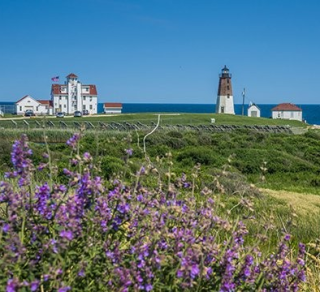
- Restoring Saltmarshes
- Protecting Seagrasses for Bay Health
- Bringing Environmental Experts in Rhode Island Together
- Assessing the Impact of Sewer Installation on Coastal Water Quality
- EPA Scientists Study the Carbon-Storing Power of Seagrass to Fight Climate Change
- Building A Resilient Shoreline: Lessons Learned from Hurricane Sandy
- Making Microplastic Identification More Accessible
- “Marshing Forward” Despite Uncertainty: How EPA Researchers are Reframing Approaches to Coastal Climate Adaptation Efforts
- Determining the Value of Clean Water: How EPA Researchers are using Social Science to Study the Human Dimensions of Water Quality in New England
- Using Sediment to Understand Hypoxia in Estuaries
- Nature's Lawnmowers: Using Goats for Landscaping
- Helping Community Drinking Water Systems Find Cost-Effective Solutions to Treatment Challenges
For more EPA work, see EPA in Rhode Island.
Nutrients and Seagrass Habitat
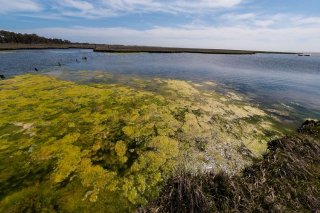
Excess nutrients flowing from the creeks, streams, and rivers of the surrounding watershed are adversely affecting the water quality of Narragansett Bay. EPA researchers in the Office of Research and Development are working with the Narragansett Bay Estuary Program on topics related to nutrient pollution and its effect on seagrass abundance, hypoxia, and algal blooms. These researchers have also developed indicators than can be used to assess and monitor the biological condition of the estuary and its resources, and they made significant contributions to the 2017 State of Narragansett Bay and Its Watershed, a technical report that serves as a blueprint for the development of conservation and management activities outlined in the Narragansett Bay Estuary Program Comprehensive Conservation Management Plan.
Restoring Saltmarshes
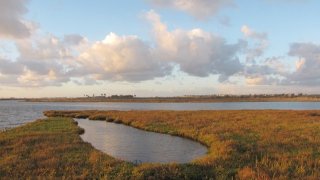
Saltmarsh habitats are nurseries, refuges, and feeding stations for estuarine life, protect shorelines, and clean water by trapping sediments. EPA scientists in the Office of Research and Development worked with partners in the state to design a project to understand how sediment application can counter rising sea levels and monitor the impacts to vegetation growth, soil pH, salinity, percent organic matter, and more.
Protecting Seagrasses for Bay Health
To better assess the health of the seagrass in Narragansett Bay over time, EPA scientists, in partnership with the Narragansett Bay Estuary Program and the University of Rhode Island, documented changes to seagrass coverage across the Bay over time and then correlated the changes they found with sources of nutrients entering the Bay. The work has led to a better understanding of how wastewater treatment upgrades have contributed to lower nutrient levels and improved the environment.
Bringing Environmental Experts in Rhode Island Together
Environmental protection works better when we work together. EPA recently hosted state and Tribal environmental experts at the Narragansett, Rhode Island, lab to talk about collaborative research opportunities, science priorities, and cross-cutting issues. Read In The Field: EPA Program Brings Environmental Experts to Rhode Island.
Assessing the Impact of Sewer Installation on Coastal Water Quality
EPA researchers have sampled the waters around the town of Wickford in North Kingstown, RI since early 2018, measuring nutrients, dissolved oxygen and several tracers of wastewater. In a collaboration with EPA Region 1 and USGS starting in 2020, EPA's Office of Research and Development (ORD) has been mapping and modeling groundwater and associated nutrient flow into the cove system around Wickford. ORD and its partners are creating a baseline for making accurate, before-and-after comparisons to assess the impacts of infrastructure improvements installing sewers. Eventually the town will use the generated data to determine if sewering has improved local water quality and demonstrate to residents how their investment is paying off in terms of local environmental improvement.
EPA Scientists Study the Carbon-Storing Power of Seagrass to Fight Climate Change
Seagrass meadows make up a powerful carbon storage system—one that, if properly managed, could help rein in global carbon dioxide emissions responsible for climate change. To get a better picture of how much carbon is stored in seagrass meadows, EPA researchers in New England sampled seagrass and sediments from 11 meadows in the region. Read EPA Scientists Study the Carbon-Storing Power of Seagrass to Fight Climate Change.
Building A Resilient Shoreline: Lessons Learned from Hurricane Sandy
EPA helped a community in Rhode Island develop strategies to protect them from future extreme weather events. Part of this effort includes working with partners to build a “living shoreline” and improving marsh condition to better withstand flooding. Read Building A Resilient Shoreline: Lessons Learned from Hurricane Sandy.
Making Microplastic Identification More Accessible
Given their variety in size and shape, there's no "one-size-fits-all" approach for measuring microplastics in the environment. Researchers at EPA recently developed a new method for identifying and counting microplastics in environmental sediment samples. Learn about their new method and how they recently used it in a case study in Narragansett Bay, Rhode Island. Read Making Microplastic Identification More Accessible.
“Marshing Forward” Despite Uncertainty: How EPA Researchers are Reframing Approaches to Coastal Climate Adaptation Efforts
Coastal areas and salt marshes are becoming increasingly vulnerable from land- and climate-based stressors such as accelerated sea level rise, droughts, flooding, and increased land development. To help protect these areas, EPA scientists evaluated both the scientific methodology and management practices behind coastal restoration projects in two areas, including a salt marsh restoration project on Ninigret Pond, Rhode Island. Using this research, they developed a framework to assist communities with collaboratively managing these fragile ecosystems. Read “Marshing Forward” Despite Uncertainty: How EPA Researchers are Reframing Approaches to Coastal Climate Adaptation Efforts.
Determining the Value of Clean Water: How EPA Researchers are using Social Science to Study the Human Dimensions of Water Quality in New England
Coasts and estuaries provide important resources for communities. To help protect these areas, EPA researchers are using social science to study the value that people place on water quality in coastal environments, including a study on coastal access in Rhode Island. This work allows environmental managers, decision makers, and individual community members to better understand the value of investing resources into water quality improvements and protection of natural environments. Read Determining the Value of Clean Water: How EPA Researchers are using Social Science to Study the Human Dimensions of Water Quality in New England.
Using Sediment to Understand Hypoxia in Estuaries
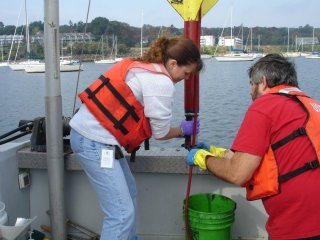
In many estuaries and coastal environments, low levels of dissolved oxygen – also known as hypoxia in water—pose a threat to habitats and local ecosystems. Hypoxia events are typically linked to excess nitrogen but the connection between the two has been difficult to determine due to the complexity of coastal environments. To better understand the link between hypoxia and nutrient inputs, EPA scientists are using a surprising method – measuring molybdenum in surface sediment as an indicator for hypoxia throughout the water above it. As part of this work, EPA researchers in the Office of Research and Development collected sediment samples from seven estuary and lagoon locations in Narragansett Bay, Rhode Island. Read Mapping with Molybdenum: Using Sediment Characteristics to Understand Hypoxia in Estuaries.
Nature's Lawnmowers: Using Goats for Landscaping
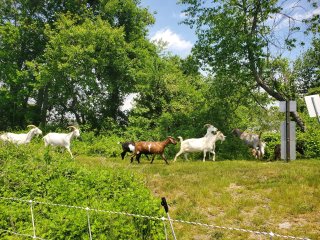
Each summer, EPA's facility in Narragansett, Rhode Island, hosts a team of rescue goats to clear the grounds of any unwanted or overgrown plants. These goat landscapers (known as goatscapers) are brought in to manage the lawns in place of using traditional landscaping practices. The goats clear invasive and overgrown plants, and in turn, they have lots of food to eat. Read Nature’s Lawnmowers: How One EPA Facility Uses Goats for Eco-Friendly Landscaping.
Helping Community Drinking Water Systems Find Cost-Effective Solutions to Treatment Challenges
Emerging contaminants, such as per- and polyfluoroalkyl substances (PFAS), are challenging to drinking water systems across the country. Effective treatment for emerging contaminants can be unknown, difficult, and extremely costly. Working with the state of Rhode Island, EPA researchers are providing technical assistance to a very small community water system with PFAS concerns to help them identify optimal, cost-effective treatment methods and optimize the long-term operation of their chosen technology. These efforts will also be used to develop best practices and performance and cost estimate tools so water utilities across the country can make informed treatment and operational choices. Read Technical Assistance for Treatment Options to Remove Emerging Contaminants.
